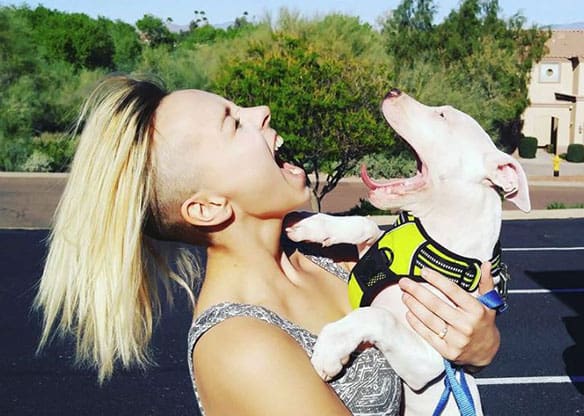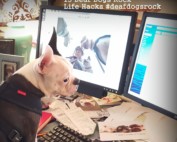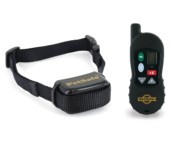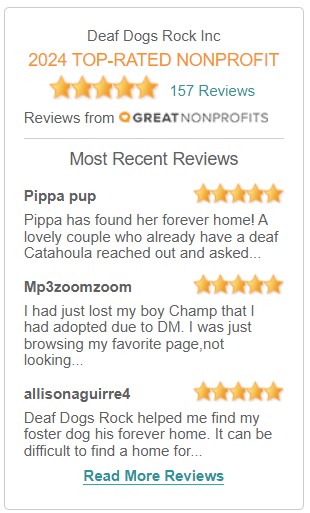I ran across this article and I thought it was written from a very realistic view point. Here on Deaf Dogs Rock we do focus on training and taking your deaf dog to the next level if you decide to adopt a deaf dog. One of the main reasons we focus on taking deaf dogs through levels training is because we are trying to change the general public’s perception of deaf dogs (all the lies and myths of aggression). The second reason why we focus on going to the next level with a deaf dog is because sometimes life throws a curve ball. Maybe a person decides to adopt a deaf dog and a few years down the road they are expecting a child. Sometimes this happens and a family will choose not to have a new born around a deaf dog (or any small children for that matter).
Many of us working in the rescue of deaf dogs find it a little more difficult to place a deaf dog that is older with no formal training and socialization. We maybe able to find a deaf dog a good home but in many cases the dog ends up back at the rescue because of poor manners or not enough socialization.
Right now on DDR we have two dogs on our “adoptable deaf dogs in need” page where the foster parents of these two dogs have stepped up their training and put them through many levels of training (see Ziggy and Rio -CGC). These two dogs have been on our adoptable deaf dogs page for months. Many deaf dog owners decide they are not in a position to go to a formal training class and they choose to work with their dogs from home because it works better for them. I did this when I first got Nitro because I had to wait two months before his classes actually started. I went out and purchased a book called “Puppy Training for Dummies” and this book has been amazing!
There are some great deaf dog training videos on YouTube as well. When it comes to learning, deaf dogs are like little sponges soaking up everything. The important thing to remember here is to have fun with your dog, be your dog’s advocate, and make sure your deaf dog is getting consistent training by you or someone else so he/she will go on to live a happy and healthy life. ~ Christina – Deaf Dogs Rock
Deaf Dog Adoption by Pam Keim
My first experience with a deaf dog occurred when I was about 16 years old and my family decided to adopt a dog from a local Humane Society. We fell in love with “Shorty” because, well, she was odd looking and seemed so very sweet. We brought her home and after a couple of hours we realized something was not right. We could clap our hands directly above her head and she did not flinch a bit. We called the Humane Society and asked if they knew the dog was deaf and they claimed they did not. They did say we could return the dog on Monday when the shelter reopened but we knew there was no way this would happen. How could we return a dog we had bonded with only because she was deaf? We never could have lived with ourselves if she had been euthanized by the shelter.
Shorty turned out to be the best dog we ever had. I trained her to sit up, roll over, sit, lie down, and shake hands. I had no formal background in dog training and was still in high school. She was apparently a very smart dog. She learned the boundaries of our property and after a few years she never left our yard. We never thought of her as having a “disability”, she was just our dog who was a little different.
The first dog I adopted after leaving home was a “hearing” dog and it actually took a while to get used to it. I had gotten used to a dog not being able to hear the doorbell ring, the potato chip bag being opened, and movement around the house. It just seemed odd to have a dog who could hear everything. Many years later, I came upon Chance, a deaf seven month old Catahoula Leopard Dog. His sad story included a breeder who wanted to euthanize him because he was deaf and a lady who rescued him from the breeder but did not have time to work with him. The Catahoula breed is notoriously intelligent, independent, energetic, and headstrong…in other words, not easy to train even on a good day.
Chance came to live with us two years ago and he has learned to sit, lie down, shake hands and walk properly on a leash. There were days that I suspected he was acting like a human teenager and was simply ignoring me instead of being deaf. He knows, at all times, what is going on in our house. He seems to know, by some sort of instinct, when I enter the kitchen. His sense of smell is amazing.
Last year, I took Chance to a puppy class offered by a local veterinarian office. Chance was incredibly well behaved (in public) which confirmed my belief that he knew right from wrong, he just chose to pretend otherwise. The other participants in the class were simply amazed that a deaf dog could be trained rather easily. In fact, Chance was doing all the same things the hearing dogs were doing in the same amount of training time. One participant told me she had told her mother how brave I was to take on such a responsibility. It never seemed to be that much of an issue.
I recently corresponded with someone who was considering adoption of a deaf dog and came to realize so many people do not realize how much of a non-issue it really is. Dogs are dogs. If you are considering adoption of a dog, hearing or non-hearing, you should be familiar with dog behavior. Second, a breed is a breed. There are certain breed specific behaviors that will be present regardless of ability to hear. Again, this is a consideration when adopting any dog. What breed will work best for your family and home environment? Third, there are a few special considerations for deaf dogs. If you already have dogs in your home, will they accept another dog into the “pack”? Remember, deaf dogs will not be able to hear that low throated growl sound that is used to warn newer dogs to “back off”. Whether or not this is an issue depends on your current situation. Deaf dogs will also not be able to hear small children approaching from behind or when they are asleep. Non-hearing dogs can be easily startled and may react by snapping. Children should be taught how to approach the new dog and not to startle it. Deaf dogs also should not be allowed off leash unless they are in a fenced in area since you will not be able to use verbal cues to recall your dog.
Training a deaf dog should not be difficult if you have experience training other, hearing dogs. There are some dog trainers who have experience in this area to help you with use of hand signals. Some deaf dog owners use hand signals similar to American Sign Language, but what really matters is the level of communication between you and your dog.
If you are contemplating bringing a dog into your family, consider adoption from a rescue organization. Please also consider adopting a deaf dog who will bring years of love to your family with only minimal additional investment in training time for you and your family.
Pam Keim is the owner of ClaimsBridge, an insurance claims consulting company, based in Orlando, FL. Pam has over 20 years experience in claims and is also a licensed insurance agent in Florida. Please visit http://www.claimsbridgeonline.com for more information on available services. Pam also is the proud “mom” to two rescued Catahoula Leopard Dogs, one of whom is deaf.
Article Source: http://EzineArticles.com/3038896







